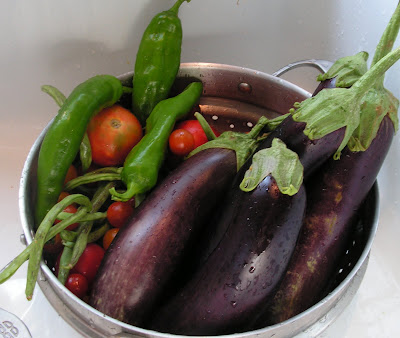Garden update 1 (6.23.2007)
Garden update 2 (6.27.2007)Stopped by your garden today. Everything's looking great. Your irrigation system must work extremely well. It hasn't been raining much but I didn't see a single plant wilting (except for one of the brugs and they always wilt a little at the hottest part of the day). Roses blooming everywwhere. One of the blue berries looked a little sad--Gulf Coast I think--but I felt the soil and it was moist, so I think it's probably still just adjusting. I picked some tomatoes and a big bag full of those rattlesnake beans. We just ate them and they were AWESOME. I've been trying to find a really good green bean for years, and I'm always disappointed in the ones I try. Lately I've been going with Romas but we like your rattlesnakes much better. Where did you hear about them? Isn't it an heirloom? The plants are very healthy still despite the heat.Hope your trip's going well. I'll stop by and check again soon.Bill
Stopped by again to today. Everything's still looking good. The sweet potatoes are sprawling out everywhere. That jatropha (?) fell over (we've been having some wind) and I set it back up but other than that everything looks fine. You have some kind of big squash developing over in the flower bed by the fence.Your amaranth is about to go to seed. I remember your post about how Nicole uses the seeds to bake, so I left it. But I have heard that if you let the seed fall you'll have amaranth everywhere. Maybe with your mulch there will be no problem. Anyway, if you want me to pull it, let me know.I picked a big bag full of tomatoes, eggplant, and more rattlesnake beans. Just had some for dinner and it was delicious. Believe it or not the rattlesnake seems to be blooming and even producing new beans despite this heat.Still no rain (though there was a fifty percent chance in the forecast today).About the roses, I feel that way everytime I go up to Georgia, where just about everything seems to grow better. I'm sure the difference is even more dramatic up where you are. It's enough to make me want to go tropical, but then I would be running around every winter covering things up and worrying about freezes.Hope everything's going well. I'll stop by again in a few days.
Just stopped by again, and everything is fine. I'm glad you're coming back soon though because those sweet potatoes and yard long beans are going to take over in a matter of days.I haven't pulled up a single tomato plant. They still have green fruits on them so you should be harvesting for a while longer. I picked another bag full of tomatoes today. We're eating gazpacho every day. Ana loves it.We have been getting some rain over the last couple of days, not much though, just an afternoon shower or two.






